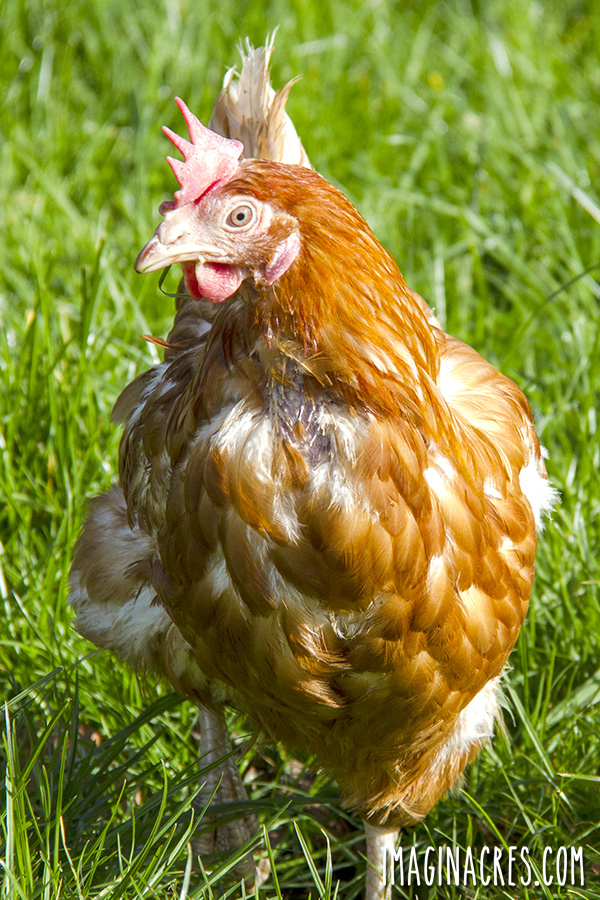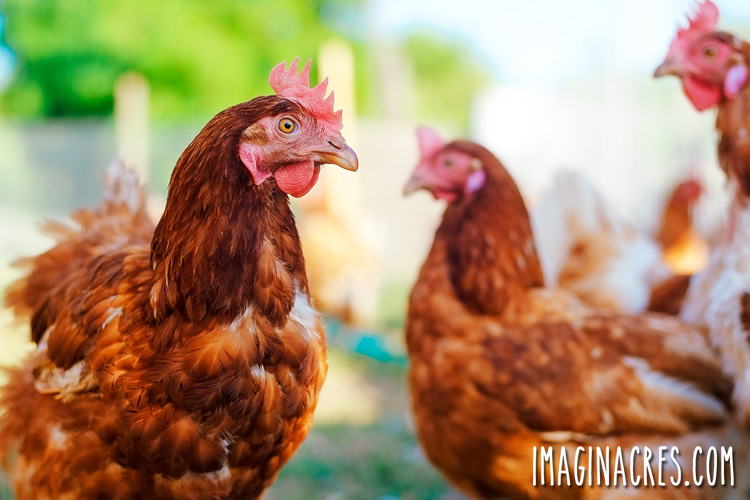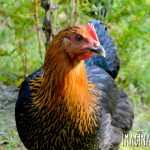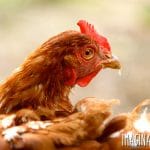Molting is a natural process birds go through where they lose their old feathers and grow in new ones. Here are tips to help you understand what is happening and how to care for molting chickens.

Are your chickens molting? Molting is a natural process birds go through where they lose old feathers and grow in new ones. Growing feathers is uncomfortable and painful. Read on to learn more about molting chickens and how to care for your flock during this time.

Oh, Martha! When she begins to molt in fall, the whole flock dynamic is in flux.
Martha, a Barred Rock is the leader of the hen house. When she begins to molt in fall, the whole flock dynamic is in flux.
She gets very grumpy and has no desire to manage her flock mates to keep them in line. When free ranging, she goes off to the opposite corner of the yard all by herself and isn’t interested in hanging out with her BFFs.
Martha’s yearly molts are hard, but over quickly. Soon she is back to normal while the other members continue to suffer through their own annual molts.
What is molting?
Molting is the process all birds go through to replace worn feathers with new ones. The old feathers fall out and fresh feathers grow. Both hens and roosters molt each fall as part of a natural cycle.
Feathers are made of a protein called keratin. Over time, this protein weakens as the feathers wear out from preening, dust bathing, and other normal activity. As damage accumulates, the feathers are no longer efficient at protecting and insulating. Each feather falls out so a new one can take its place.
If you raised hens from chicks, you will have observed several juvenile molts. The first molt happens when the chick is about 7-days old when the downy fuzz falls out and is replaced by small feathers.
Another juvenile molt occurs around 10-weeks when the pullets’ small feathers are replaced with a set of adult feathers. There are additional mini-molts until the pullets become layers at around 22-weeks. Adult chickens then settle into a yearly molting routine.
When do adult chickens molt?
Generally, adult chickens and roosters molt every year in late summer or fall. Natural molting is triggered when the daylight decreases. Adult chickens that are at least 18 months old begin to lose worn out feathers and grow in new ones. Some chickens also go through a light molt in spring when the daylight begins shifting again.
Of course, there are exceptions:
- First year chickens: Young adult chickens may not molt the first year depending on their age.
- Sick or stressed chickens: Molting may occur out of season if your chickens are ill or stressed out from a lack of food, water, or light.
- Broody hens: Hens that are finished hatching eggs will molt when they return to their normal eating, drinking, and egg laying routines.
- Additional lighting in the coop may also shift the molting cycle.
Signs you have molting chickens
It is shocking to find a bunch of feathers in the coop and pen, but there are some signs your chickens are molting:
Feathers look dull and ragged:
Just before your chickens begin molting, the feathers lose their normal sheen and bright color. They will look a bit tattered, and no longer lay smooth. Essentially, the feathers are worn out from normal activities over the past year from preening and dust bathing.
You will start to see loose feathers:
Soon, you will notice a few small feathers accumulating in the chicken coop or pen. Not all members of the flock will begin molting at the same time, but they usually keep the same schedule each year. My head hen, Martha the Barred Rock kicks off molting season every year, and then the rest of the flock follows.

Your chickens will slow or stop laying eggs:
Along with the molting cycle, decreasing daylight hours also triggers the hens’ reproduction cycle to rest. When your hens begin molting, most slow or stop laying eggs until the daylight hours increase again in late winter into spring.
The combs and wattles get dull:
While your chickens are molting and have stopped laying, their comb and wattles will go from bright red to pale pink.
You will see bald spots:
The process of molting occurs over a period of time as feathers fall out and are replaced. You may see bare patches as feathers in sections of the body fall out and begin growing in.

Grumpy flock of hens:
When the flock is molting, the dynamic of the pecking order is challenged. Growing feathers is painful and losing feathers may cause a hen to feel more unprotected and vulnerable than usual. You might find the flock squabbling more frequently when they are molting.
You will also observe personality changes in your chickens. That special hen that greets you each day, may simply want to hang out in the corner dust bathing while she is molting.
What happens to chickens when they molt?
The process of molting occurs over a period of time as feathers fall out and are replaced. When chickens molt, it usually goes through a certain order beginning at the head and neck feathers, followed by breast, body, wings, and tail.
When a feather falls out during a normal molt, a new feather is stimulated to start growing right away. The new feather grows out of the skin as a pin feather, a shaft encased in a waxy keratin sheath. The new feather has a blood supply flowing through the quill to nourish the feather as it develops. At this point, if a feather breaks, it will bleed. The shaft eventually flakes away as the quill lengthens, grows barbs, and the new feather emerges.

When the feather finishes growing, the blood vessels die back, and the quill becomes hollow. This makes feathers lighter and also means that if the chicken breaks a feather at this point, it will no longer bleed.
Some chickens molt faster than others. You may open up the coop one morning and find so many feathers that you may wonder if a pillow fight happened overnight. Others molt slowly, only dropping a few feathers here and there as they go about their business.
Generally, your most productive layers will molt quickly, and the poor layers and older hens will take their time. It can take 8 to 12 weeks for a chicken to finish molting. Slow molters may take as long as 18 to 24 weeks to grow in their new feathers.

Tips to Care for Molting Chickens
If you are close with your flock, you will notice personality changes as the feathers begin to fly. Most molting chickens retreat to quiet spaces, reduce their activity, and just want to be left alone.
Molting takes a lot out of a chicken. Make sure your flock has plenty of clean water and food at all times. You may want to place an additional feeder in another area of the coop or pen so even the most timid chicken has access to food.
Here are other ways to help your molting chickens through the feather replacement process:
Increase protein in your flock’s diet
Since feathers are made of about 85% protein, ensuring the flock has enough protein in their diet will help them get through the molt period quickly and grow healthy feathers.
Switch your flock’s diet to a higher protein feed. There are several, “feather fixer” chicken feeds now on the market that provides extra levels of protein and nutrients. Seek out a complete feed with around 20% protein. Once your chickens are finished molting, switch back to their regular feed.
A flock that enjoys free ranging time will find high protein bugs, worms, and seeds. You can also feed a handful of high protein treats like black oil sunflower seeds, mealworms, pumpkin seeds, and even scrambled eggs.
Reduce stress during the molt
The process of molting is both painful and stressful on chickens. Try to keep the flock calm and anxiety level low during the molt.
Make sure your flock has access to plenty of food and water, avoid making changes to their environment, and don’t introduce new chickens to the flock during the annual molt.
My flock hates it when it is windy and prefers the protection of their pen. I try not to free range on windy days when they are molting because it only stresses them out.
Avoid holding molting chickens
Growing feathers is uncomfortable and painful. The spiky new pinfeathers are tender until it is fully grown. Any bending, rubbing, or pressure can hurt. Try to avoid picking up and holding your chickens during the molting period.
Keep your molting chickens busy
Some hens will want to remain calm by resting or dust bathing, while others may be bored and restless. Keep these chickens entertained with plenty of things to dig, scratch, and eat.
What to Do When Your Chickens Finish Molting
Once your flock is finished molting, it is a great time to do some cleaning in your coop and get it ready for the cold winter months.
It will be a while before your hens resume laying, but clean out the nesting boxes and fill with fresh shaving.
Go ahead and switch back to your regular chicken feed. Give all the feeders and waters a good scrubbing and fill with fresh food and water.
Now is a great time to start with the Deep Litter Method in the Chicken Coop. Remove all the soiled bedding and feathers. Sweep out the dust and cobwebs, and replace the bedding with a layer of fresh clean shavings, leaves, or straw.
—
I hope these tips help you care for your molting chickens. It’s not easy to watch your flock going through what looks like a miserable situation. Soon they will show off new, shiny feathers, and back to their normal chicken antics.
Research and Further Reading:
- The Chicken Health Handbook by Gail Damerow
- Everything You Need To Know About Feathers by Bird Academy, Cornell University
- Storey’s Guide to Raising Chickens by Gail Damerow





Leave a Reply